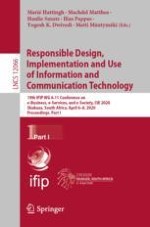This two-volume set constitutes the proceedings of the 19th IFIP WG 6.11 Conference on e-Business, e-Services, and e-Society, I3E 2020, held in Skukuza, South Africa, in April 2020.*
The total of 80 full and 7 short papers presented in these volumes were carefully reviewed and selected from 191 submissions. The papers are organized in the following topical sections:
Part I: block chain; fourth industrial revolution; eBusiness; business processes; big data and machine learning; and ICT and education
Part II: eGovernment; eHealth; security; social media; knowledge and knowledge management; ICT and gender equality and development; information systems for governance; and user experience and usability
*Due to the global COVID-19 pandemic and the consequential worldwide imposed travel restrictions and lockdown, the I3E 2020 conference event scheduled to take place in Skukuza, South Africa, was unfortunately cancelled.
